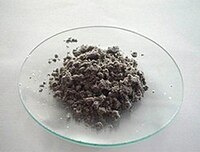
Photo from wikipedia
Abstract δ-hydride structures in Zr nuclear fuel-rod cladding significantly affect mechanical properties. A micromechanical phase-field model is developed to investigate the effect of interfacial energy anisotropy and elastic interaction on… Click to show full abstract
Abstract δ-hydride structures in Zr nuclear fuel-rod cladding significantly affect mechanical properties. A micromechanical phase-field model is developed to investigate the effect of interfacial energy anisotropy and elastic interaction on the nucleation, stacking structure formation, and stacking structure transition of δ-hydrides. It is found that the nucleation probability and growth of δ-hydride near pre-existing hydrides are strongly spatially dependent. Results show that (1) the δ-hydride has a platelet-like shape. The large shear deformation associated with lattice mismatches and a small interfacial energy of its broad interface cause the orientation of the δ-hydride off the basal plane approximately 14.7°. (2) Stress-induced nucleation of δ-hydrides near a pre-existing hydride results in the unique stacking structure formation. (3) The morphology and alignment of stacking structures, called as macroscopic hydrides which consist of microscopic hydrides with certain stacking sequences, change under stresses. The alignment of macroscopic hydrides changes from along the circumferential direction to along the radial direction under tensile hoop stress while the orientation of microscopic hydrides remains parallel to the basal plane. These results are in agreement with experimental observations. The simulations reveal that stress-induced heterogeneous nucleation and growth is the mechanism for the formation and transition of unique macro-hydride stacking structures.
Journal Title: Acta Materialia
Year Published: 2019
Link to full text (if available)
Share on Social Media: Sign Up to like & get
recommendations!